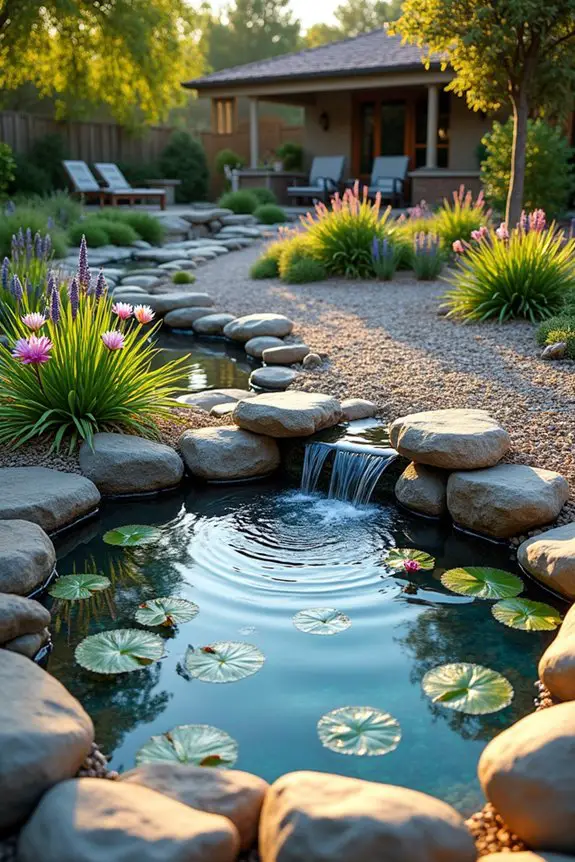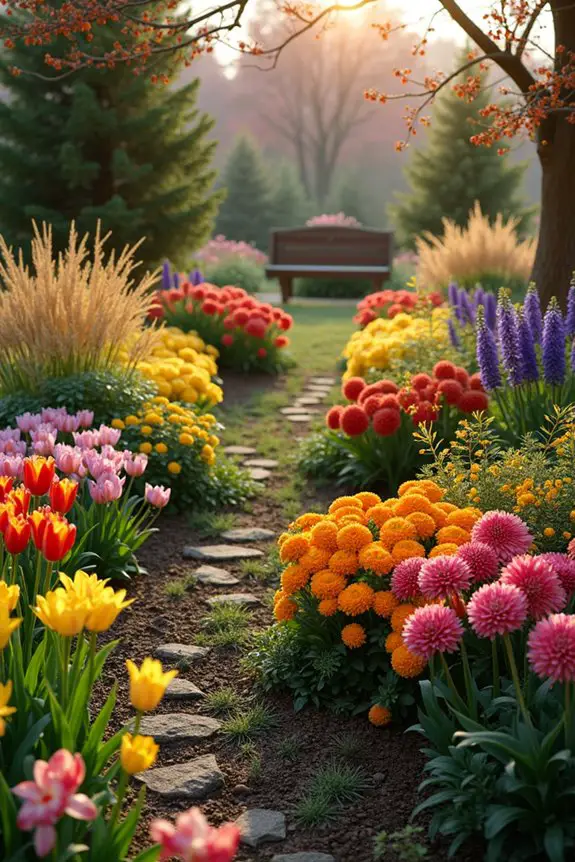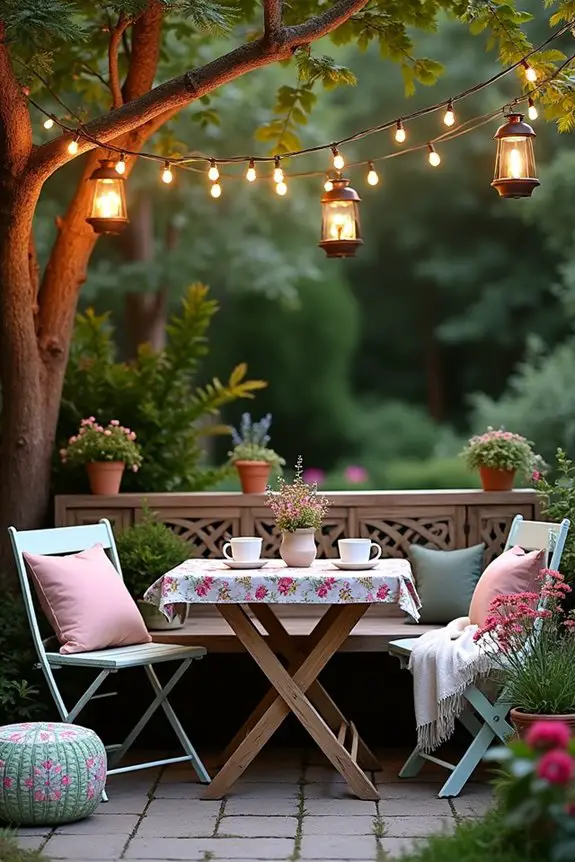Thinking about sprucing up your outdoor space with a gravel garden? You’re in for a treat. Imagine creating a cozy retreat with layered gravel, colorful stones, and low-maintenance plants that practically thrive on neglect. You know, plants like succulents? They’re not just trendy—they’re drought-resistant too. And how about those winding paths? They can lead your guests—or maybe just you—to a hidden nook. So, where do you begin? Let’s explore some genuinely inspiring ideas.
Natural Stone Accents
When you’re thinking about adding some natural stone accents to your gravel garden, imagine how they’ll play off your plants and gravel patterns.
You could choose sustainable plants that complement textured gravel arrangements, mixing colors and levels for a stunning visual treat.
Have you ever considered how a layered gravel layout can create that Zen vibe, where everything feels perfectly in place?
1. Sustainable Plant Selections
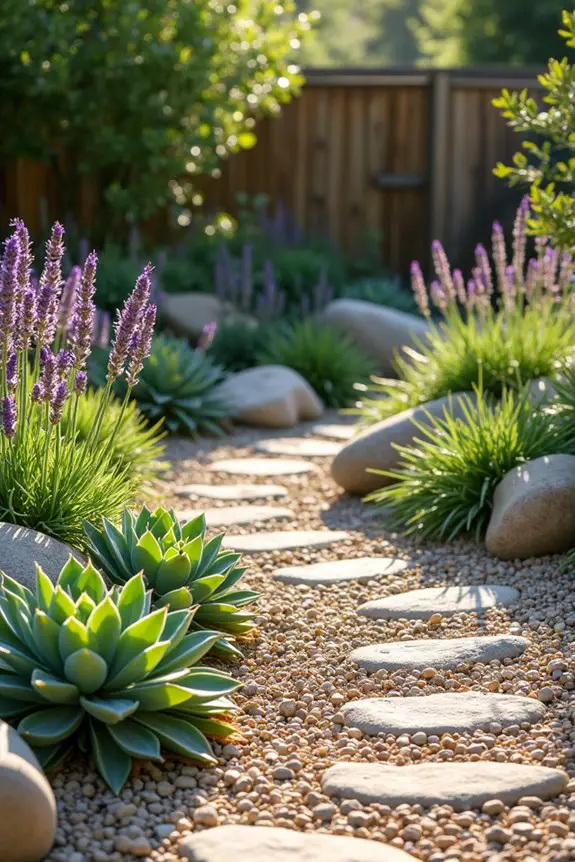
When it comes to designing a gravel garden, choosing sustainable plant selections paired with natural stone accents is a total game changer. Not only do these elements help the environment, but they also create a chic, serene vibe that makes your outdoor space feel like a stylish retreat. Envision this: a lush plant here, a pop of stone there – it’s like nature’s own artwork.
Let’s start with plants. Think low-maintenance varieties that thrive in gravel. Succulents are a fantastic choice – they’re tough, drought-resistant, and come in so many quirky shapes. Then there’s lavender, with its lovely scent and beautiful blooms. Trust me, bees and butterflies will thank you. Plus, you’ll be graced with their delightful presence, which is like having tiny nature fairies flitting about. Incorporating foldable garden waste bags can also make clean-up a breeze while maintaining your garden’s aesthetic.
Now, for the stone accents. Choose natural stones that complement your plants. Imagine a rough, textured boulder nestled among soft, leafy greens. It creates a perfect contrast, making both the stones and plants pop. You can also use smaller gravel stones to create pathways or borders. Think of it as nature’s decor – isn’t that just satisfying?
Consider arranging the stones in playful patterns; it adds an artistic touch without much effort. Just remember to keep your design balanced. If you place a hefty rock on one side, maybe throw in some smaller crush stones on the opposite side to keep things harmonious.
Balance is key – kind of like when you have a heaping plate of nachos and need to balance out the cheese with guacamole (which, let’s be honest, is the real star of the show). Additionally, using a metal landscape rake can help maintain the perfect gravel texture and ensure your garden looks pristine.
2. Textured Gravel Patterns
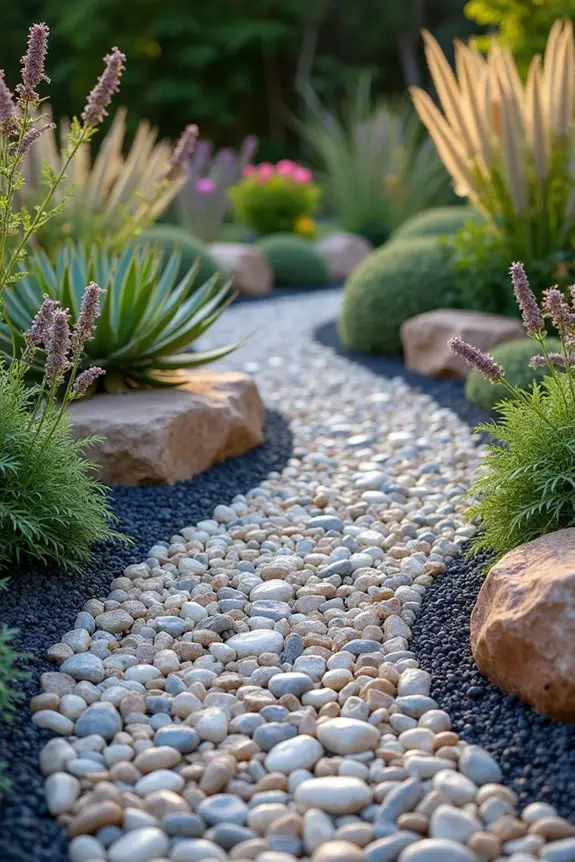
Texture in your gravel garden doesn’t just look good; it also adds a layer of interest that can transform a flat outdoor space into a three-dimensional haven. It’s like layering flavors in a delicious dish; each ingredient has its own personality, but together they create something truly special. By mixing different types of gravel and stones, you can establish unique patterns that bring your garden to life.
Start by selecting a few different grades of gravel. Think coarse gravel paired with fine pebbles – it’s all about contrast. Envision stepping stones made of large, rustic boulders scattered among a sea of smooth, tiny pebbles. Your feet will happily dance along the path, feeling the delightful differences underfoot. Plus, this texture variation not only looks great, but it also helps with drainage, ensuring your plants don’t drown when it rains. Proper drainage is essential for maintaining healthy plants and promoting optimal growth.
Now, let’s talk about design. Visualize a winding path made of smooth, round stones, surrounded by jagged, angular rocks. It’s an eye-catching blend that guides you through your garden, making each step an engaging experience. To get creative, try arranging the different stones into geometric shapes or playful spirals. This can make even the most straightforward space feel like an artistic masterpiece.
Don’t forget about borders. Use larger stones as a frame, holding in the gravel and providing a clean edge to your design. It’s like putting the final touch on a beautiful painting: it can really pull everything together.
While you’re at it, think about adding some plants with contrasting textures alongside your gravel patterns. Something spiky next to soft foliage creates a feast for the eyes. Additionally, incorporating ratchet pruning shears into your gardening routine can make maintaining your plants easier and more efficient.
And if you’re nervous about getting it wrong, don’t sweat it. Garden design is about trial and error. If you hate the way a pattern looks, you can always just move things around. Life’s too short to stick with an ugly garden, right?
3. Colorful Gravel Arrangements
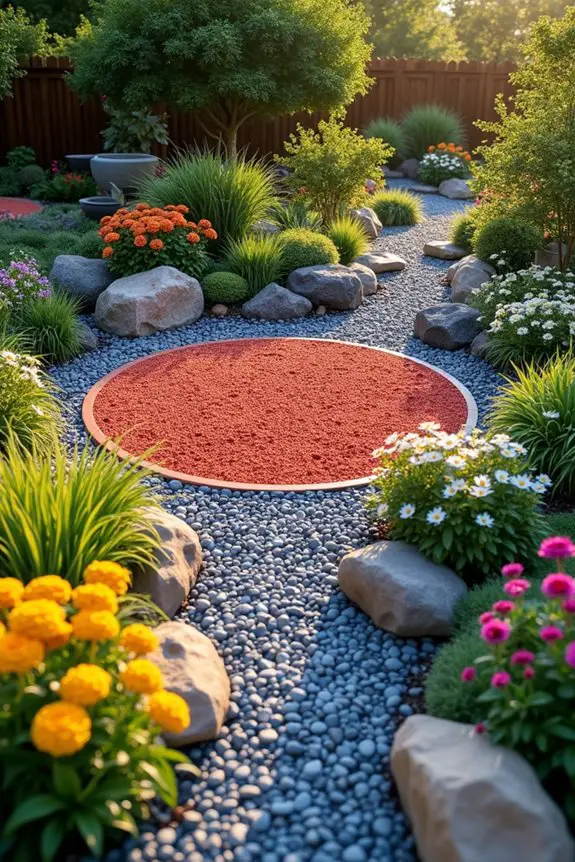
When it comes to designing a gravel garden, color is like the seasoning in a recipe—it brings everything to life. Choosing colorful gravel arrangements can create a vibrant atmosphere, elevating your outdoor space from ordinary to extraordinary. Plus, it’s not just about looks; colored stones can complement your plants beautifully, making your garden feel cohesive and inviting.
To start, consider a mix of colored gravel that harmonizes with the hues of your plants and the surrounding landscape. Think of it as creating a mood board. You might go for warm tones like reds, yellows, and oranges for a cozy, welcoming vibe, or cool blues and greens for a calming, serene effect. Visualize how those vibrant colors will pop against the earthy greens of your plants. It’s like dressing them up for a party.
Now, let’s get specific. You might create a circular area filled with bright red and yellow gravel, surrounded by lush green foliage. Or you could design a gentle pathway meandering through your garden using different shades of blue stones, leading the eye and inviting exploration.
Don’t be afraid to get experimental—layer smaller stones over larger ones for dimension, or create a calming gradient effect, where colors shift seamlessly from one to another. Consider using natural stone accents to add even more personality. Adding stylish plant holders can also enhance the overall aesthetic of your garden, giving your plants a beautiful showcase.
Think about placing a few eye-catching boulders or larger rocks that mirror the colors of your gravel. It’s like adding charms to a bracelet, making your garden feel unique. You could even tuck in some colorful flowers that match your gravel hues, encouraging nature to join in on the color fun too!
4. Layered Gravel Levels
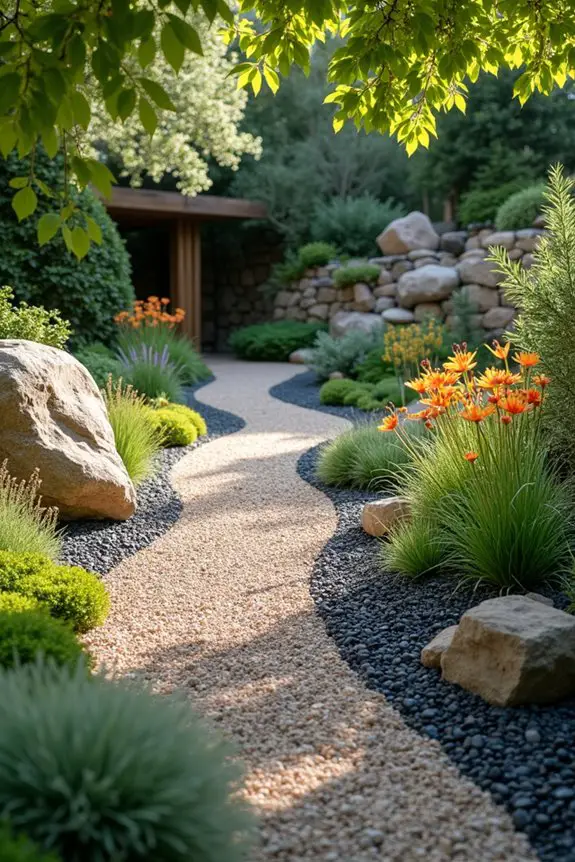
When it comes to creating a gravel garden, layered gravel levels are nothing short of a game changer. Not only do they add visual interest and depth, but they also serve practical purposes, like managing drainage and highlighting different plant heights. Envision this: your garden becomes a beautiful, tiered landscape, drawing the eye in and inviting exploration. It’s like crafting a delicious multi-layered cake, where each level offers a different surprise.
Start by imagining your garden divided into distinct zones. You could create a lower level, filled with vibrant, smaller pebbles that hug the ground, showcasing your favorite low-growing plants. Then, elevate another area with larger stones, allowing them to serve as a platform for taller, more dramatic foliage. It’s as if you’re arranging furniture in your outdoor living space, ensuring each piece shines in its own right but also works well together.
For added personality, consider incorporating natural stone accents. You can find lovely boulders or interesting slabs that mirror the colors and textures of your gravel. Position them strategically, perhaps as a rustic seat or a focal point among your layered gravel. This not only breaks up the uniformity but also connects your garden with nature in a way that feels organic. Honestly, there’s something satisfying about thinking, “Wow, that boulder really does look like it belongs here.”
As you create these layers, don’t forget to play with shapes and textures. Mix polished stones with rough, jagged edges to create contrast. It adds a bit of drama—kind of like when your favorite character does something unexpected in a movie.
And, remember to leave little paths for strolling, because who doesn’t want to wander through their own picturesque fairy tale?
5. Zen-inspired Gravel Layout
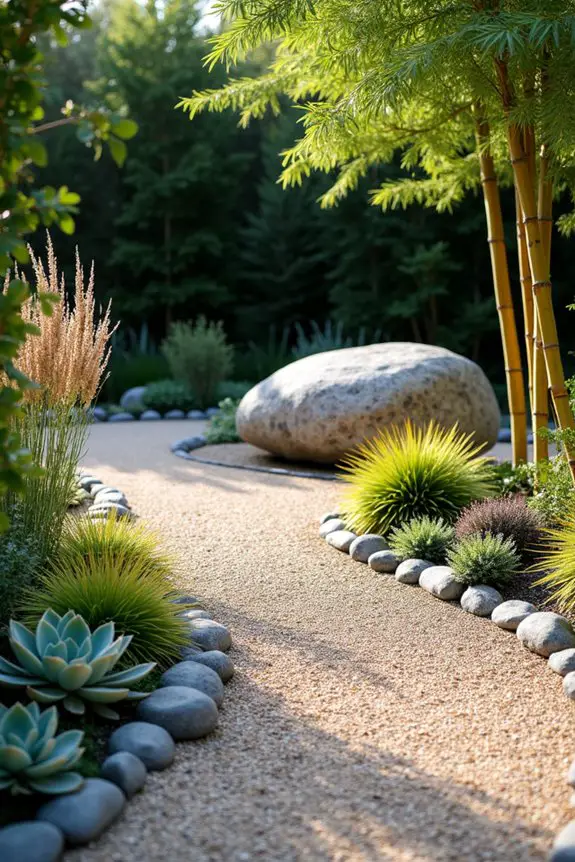
Creating a zen-inspired gravel garden is like inviting tranquility right into your backyard. The combination of serene gravel paths and natural stone accents not only looks stunning but also promotes a peaceful atmosphere, perfect for meditation or just enjoying a moment of calm. Think cozy coffee date with nature—that’s the vibe we’re going for here.
Start by choosing a few different sizes and colors of gravel that resonate with that peaceful feeling. Soft whites, earthy grays, and warm browns are fantastic choices. Imagine walking on a gentle beach, where each step feels grounding.
Next, create a simple layout. Use smooth, rounded stones to line pathways, inviting your feet to glide over them as if you’re floating through a serene landscape. Design wide, sweeping curves; these help our minds relax and travel gracefully through the garden.
Now, for the fun part—natural stone accents. Look for boulders or larger stones that feel like they’ve been placed there by nature, almost as if they’re ancient guardians. You might find a unique piece that has a fascinating texture or interesting pattern. Placing it in a focal area can draw the eye while adding that earthy vibe. Picture that majestic stone standing proudly among your gravel, acting like a sentinel of peace.
And don’t forget about plants. Complement your zen garden with bamboo, succulents, or ornamental grasses swaying gently in the breeze. They bring a touch of life and softness to the rigid lines of gravel and stone. Honestly, it’s a game changer to sit back and watch the sunlight dance off the stones while the plants rustle softly.
6. Wildlife-Friendly Design Features
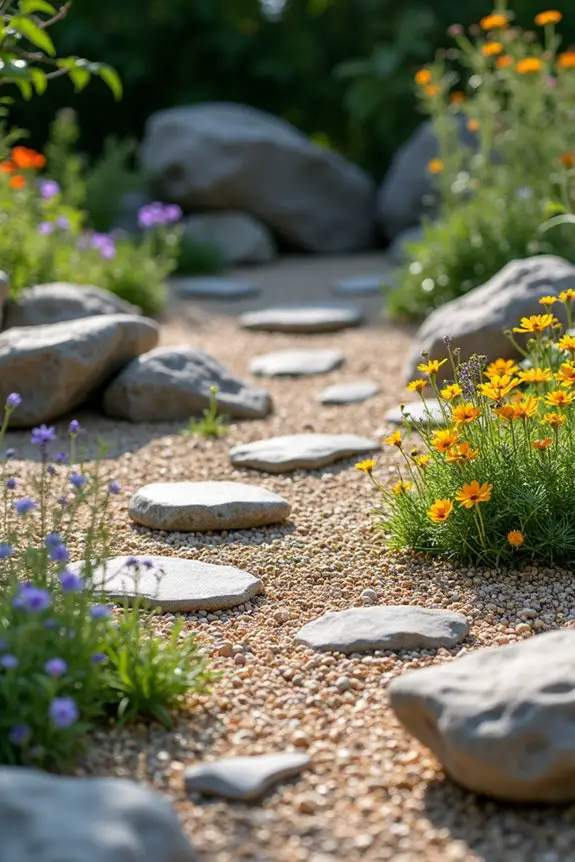
When thinking of a wildlife-friendly design for your gravel garden, natural stone accents can work wonders. Not only do they catch the eye and add texture, but they also provide essential habitats for critters like insects, frogs, and small birds.
Picture a rugged stone formation that invites life in—a cozy, little home for our tiniest friends while creating a rustic vibe that blends seamlessly into nature.
Start by incorporating flat stones or boulders in various sizes throughout your space. Imagine them as mini mountain ranges where tiny creatures might wander. Make sure to leave plenty of gaps and crevices—these nooks and crannies can be perfect hiding spots for little bugs and lizards looking for a quick snack or shelter from a predator.
And don’t worry, no one will judge if your boulders look a bit piled up like the aftermath of a teenage rock concert—this chaotic charm is what makes it feel natural.
When selecting your stones, think locally. Using natural stones native to your region not only supports the local ecosystem but also helps those stones blend in with their surroundings. You can almost hear Mother Nature giving you a nod of approval for your decisions.
Besides, who doesn’t want to feel a little eco-friendly pride while sipping coffee in their backyard?
To take it a step further, consider adding a few small plants or flowers that attract pollinators, like bees and butterflies, near your stone accents. Imagine a little patch of bright blooms next to a weathered stone wall, inviting the flutter of delicate wings.
It’s like a garden party, but for nature. So while your garden remains a serene escape for you, it’s also transforming into a lively habitat full of buzzing excitement.
7. Pathway Integration Techniques
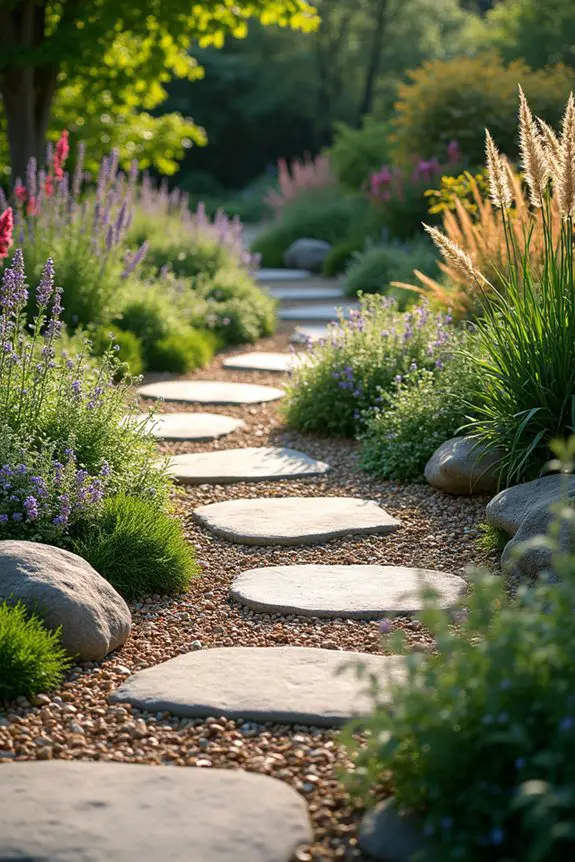
When it comes to integrating pathways into your gravel garden using natural stone accents, you’re not just laying down a trail; you’re creating a journey. Imagine wandering down a beautiful path bordered by striking stones that not only guide your footsteps but set the tone for your garden’s vibe. It’s functional and pretty—who doesn’t love that combination?
First, let’s consider the layout. You want your path to flow naturally through your garden, so avoid straight lines—unless you’re going for that military precision aesthetic, which, let’s be honest, is kind of boring. Instead, opt for gentle curves that mimic nature’s own design. Think about the way streams wind through a landscape, and let that inspire how you place your stones. Remember, life’s full of twists and turns, and so should be your pathway.
Next, spacing is key. You don’t want to trip on your stones while trying to feel like a graceful woodland nymph. Keep your stones about a foot apart to allow enough room for the gravel to fill in between. This not only enhances safety but also makes the path feel more inviting and cozy, like an old friend waiting for you.
And when it rains… well, a little gravel can absorb some water, keeping muddy shoes at bay, which we all appreciate.
Now, let’s talk about those stones. Choose various sizes and shapes to create some visual interest. Think about mixing flat stones with larger boulders—imagine a cute little family of rocks, each with a unique personality. You might even find yourself naming them, like “Rocky the Wise” or something absurd like “Boulder McSnuggles.” The more unique, the better!
Finally, don’t forget to add some greenery along the sides. Small, hardy plants like creeping thyme or sedums can spill over the edges, softening the hard lines of your path and making it feel like you’re strolling through a picturesque fairy tale. Plus, who doesn’t want to feel like they’re participating in a magical narrative?
8. Geometric Layout Options
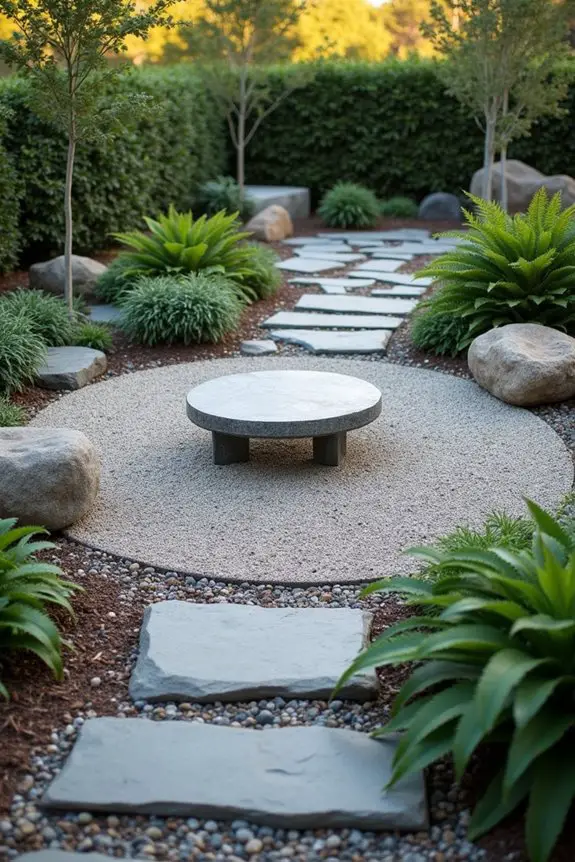
When thinking about your gravel garden, geometric layouts with natural stone accents can bring a delightful twist to both functionality and style. Imagine a space that feels both structured and free, a delicate balance between nature’s whimsy and human creativity. If your gravel garden is a book, then these geometric patterns are its eye-catching cover—inviting, intriguing, and just a tad mysterious.
To start, let’s consider the most popular geometric shapes: circles, squares, and triangles. Each of these offers a different vibe. A circular design can create a cozy gathering spot, perfect for those intimate evenings with friends—or for your cat, who may think those stones are a throne.
Meanwhile, square layouts lend a more formal feel, giving off an air of sophistication. And don’t underestimate triangles; they can lead your eye into the garden, guiding your thoughts deeper into nature’s adventures.
When laying out your stones, think about the scale. Large stones as corner anchors can provide stability, while smaller stones can fill in the gaps, offering a kind of visual jazz that complements your gravel. Just be sure to measure carefully. I once ended up with a lopsided triangle that looked like it had been run over by a truck. Spoiler alert: it was me trying to rearrange my stones after a late-night snack binge.
Next, think about the color contrast. Light gravel with darker stones creates a stunning visual dance—like a pair of socks that don’t match but somehow work beautifully together. This mismatch can make your garden feel more expansive while giving it personality.
And if you’re feeling adventurous, introduce some unexpected shapes with your stones. Let them mimic clouds or leaves, because who says hardscaping can’t be a little whimsical?
Finally, don’t forget about pathways and how they fit into your geometric plan. They can guide visitors through your design, creating movement without the need for rocket science.
Think of your path not just as a way to walk but as part of the artwork itself, shifting from one shape to the next, inviting exploration. It’s often said that bravery is just a little bit of planning—so don’t hesitate to play with your design until you find something that feels just right for you.
9. Focal Point Arrangement Techniques
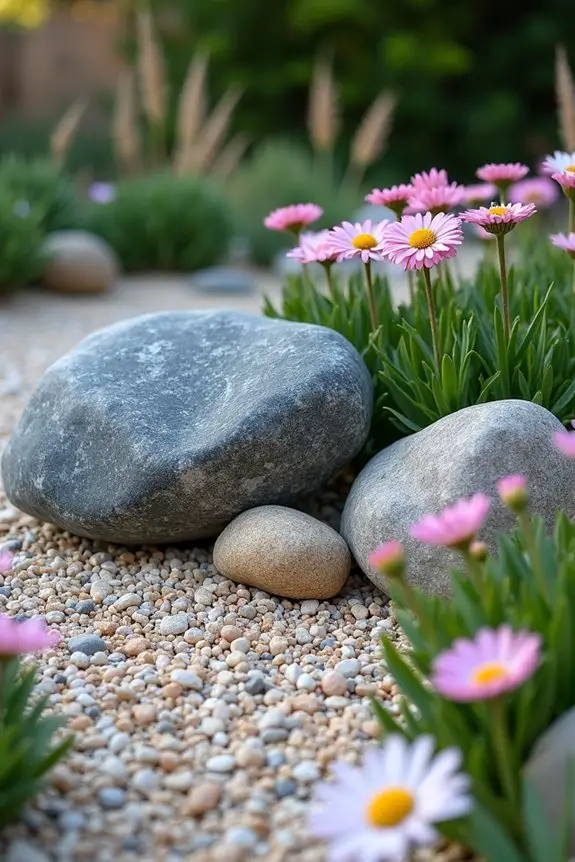
When it comes to gravel gardens, using natural stone accents as focal points can truly elevate your space. Not only do they add a touch of artistry, but they also create visual interest that draws the eye, pulling people into the heart of your garden.
Picture it: you’re walking among the stones, and suddenly, there’s a stunning boulder or a uniquely shaped rock that makes you pause and admire. It’s like a surprise guest showing up at your favorite gathering—you didn’t expect it, but you’re delighted they’re there.
Start by selecting a few standout stones that really catch your eye. Maybe it’s a chunky granite boulder with interesting striations or a smooth river rock that feels cool under your fingers.
Arrange these stones in a way that feels natural yet intentional. You want them to be the stars of the show, but not like they’re trying too hard. My last attempt at a stone arrangement ended up looking a bit like a toddler’s abstract art project—stones everywhere, confusion abounding. I decided to keep it simple instead of channeling my inner Picasso.
Next, consider how these focal stones interact with the gravel around them. Choose gravel that complements the colors and textures of your stone accents, like a good outfit pairing.
Light pebbles can enhance darker stones, while darker gravel can emphasize lighter accents. And don’t skimp on the spacing! Give your focal points room to breathe, kind of like how you need a bit of personal space when someone stands too close in line at the grocery store.
To tie everything together, think about what’s nearby. Plants or flowers that frame your stones can create a sweet little vignette.
I once planted some daisies too close to a lovely stone, and they overshadowed it, having a bit of a plant party all on their own. Now, I always aim for balance—just the right amount of greenery enough to highlight those natural beauties without stealing the spotlight.
10. Aquatic Element Integration
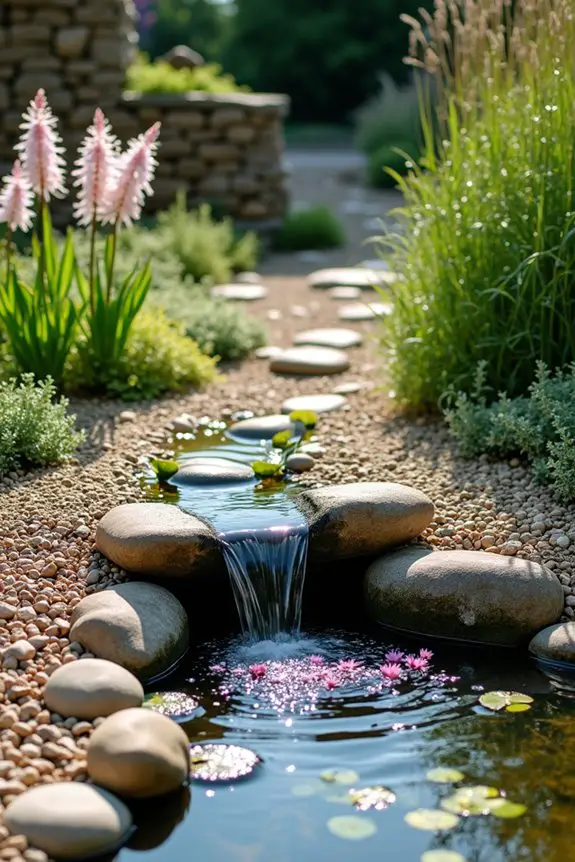
Integrating aquatic elements into your gravel garden can create a serene oasis that feels both invigorating and enchanting. Not only do water features provide a soothing sound that calms the mind, but they also introduce a whole new dimension of texture and movement. Imagine the gentle babbling of a little stream or the soft gurgle of a pond—it’s like nature’s own soundtrack playing softly in the background. Who wouldn’t want that kind of vibe?
When planning your water feature, consider how it interacts with those fabulous natural stone accents we’re already raving about. A small pond nestled among your rocks or a meandering stream can really anchor the space. I once tried to create a mini waterfall, but let’s just say it turned into a hilarious mishap when my water pump decided to take a break.
So, tip number one: make sure you have a reliable pump. It’s a bit like cooking—you want to get all your ingredients lined up before you start your masterpiece.
As for placement, aim for balance and harmony. Position your aquatic feature so that it’s visible from different angles, almost like giving it a front-row seat in your garden. Surround it with smooth stones and interesting gravel to tie everything together—sort of like the way a good salad dressing brings out the best in each leaf and veggie.
Heck, even adding some water lilies or native marsh plants can deepen the beauty, but don’t even get me started on my last attempt with plants; they decided to throw a ‘root party’ and took over the whole pond.
And here’s a gentle reminder—don’t be afraid to experiment. Maybe you want a small, koi-filled pond, or perhaps a minimalist water bowl that reflects the sky; go with what resonates with you. It’s your garden world, after all.
The goal is to create a peaceful retreat that makes you feel happy and serene. Just remember, if at first, you don’t succeed, you might end up with a quirky water feature that becomes a conversation starter among friends. And sometimes, that’s what gardening is all about, right?
Maintenance and Soil Preparation
Although you might think of a gravel garden as low-maintenance, a little bit of love and care goes a long way in ensuring it thrives. You’ve got to prep your soil like you’re making a killer gravy—mixing in organic matter enhances drainage. So, shake hands with compost and blend it into that soil.
Gravel gardens may sound easy, but a little TLC—like compost for soil—is key to making them shine!
For your gravel garden ideas, think about weed control; a layer of landscape fabric can be a hidden gem.
Don’t forget to check for pesky weeds that might sneak through. Regular raking keeps the gravel fresh and evenly spread, so it’s always looking sharp.
And honestly, a good hose-down now and then might just make you the neighborhood envy. Who knew gravel could be this sassy?

